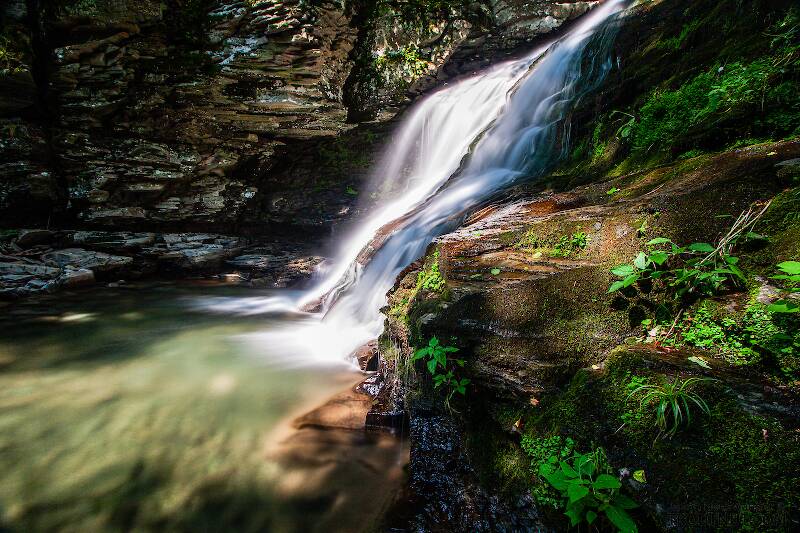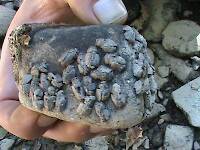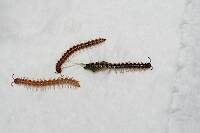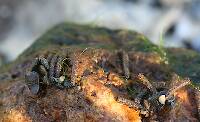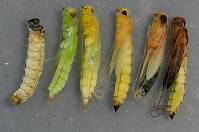
Hex Mayflies
Hexagenia limbata
The famous nocturnal Hex hatch of the Midwest (and a few other lucky locations) stirs to the surface mythically large brown trout that only touch streamers for the rest of the year.
Featured on the forum

With a bit of help from the microscope, this specimen keys clearly and unsurprisingly to Hydropsyche.

Troutnut is a project started in 2003 by salmonid ecologist Jason "Troutnut" Neuswanger to help anglers and
fly tyers unabashedly embrace the entomological side of the sport. Learn more about Troutnut or
support the project for an enhanced experience here.
PaulRoberts on Apr 9, 2012April 9th, 2012, 9:11 am EDT
Spent another week in the Hudson Highlands forest reserve, this time with my 10yr old son who was turned loose with a John Deere “Gator” full of hippers, buckets, and nets. He caught salamanders, frogs, a snake, brook trout, and assorted other critters. We set hoop nets for turtles but a cold snap kept the reptiles at bay. We did manage to capture a beaver in a suitcase trap. My son was "forced" to take a day and go see the American Museum of Natural History and almost cried having to leave that forest behind for a day. Poor kid, huh? “Why see bones and dioramas when I can catch ‘em myself”, he complained. We set up several aquariums for our captures as they were to be video’d after we left.
Some critters to share… The ponds and bogs we sampled were veritable jungles with nearly each scoop crawling and flipping with damsels, dragons, hemipterids, amphipods, dipterids, water beetles, frogs, tadpoles, newts, … etc. These are warmwater habitats but should be of interest:



We caught all three of the major families of dragons. These are Aeschnids (Darners).
Look at the length of these two neato cases. Dunno who they are:



My son’s goal was to catch a water scorpion and a giant water bug. The first he caught right away and found it to be as voracious as he’d hoped. We caught many young giants but an adult, a “giant giant”, eluded us until toward the end I managed to catch one. And it somehow crawled from my net while we hiked out to the bucket we’d left in the Gator. Boy, was my son disappointed. But on the very last day, and on the very last scoop!, in a wonderful sphagnum bog my son caught a “giant giant”, which we brought triumphantly back to the lab.
I’m including two image of this Leptophlebia dun to show how lighting can affect color in photos. The first was natural light at the edge of a forest. The second with the LED my camera has for macro work.



This was my trophy for the trip, a tiny sunfish I had never seen before. They lived under dense vegetation in the natural pond/bog we were sampling. I checked past survey records and banded sunfish were recorded for this pond. It is closely related to blue-spotted sunfish but id requires a scale count, which I did not know to do. The banded is slightly finer scaled than the blue-spotted, and these guys look rather coarse scaled in the images, but I cannot get a proper count from these images. I’ll have to take the survey biologists word for it.
CORRECTION:
So the Adirondack Lakes Survey Survey I'd read that ID'd these sunfish as banded (E. obesus) are actually blue-spotted (E. gloriosus).
As per:
Rachlin, J.W. , A. Pappantoniou, and B.E. Warkentine. 1993. Populations of
(Enneacanthus gloriosus) not (E. obesus) are in the lakes of Black Rock Forest, Orange Co., NY. 49th Annual Northeast Fish and Wildlife Conference.
Atlantic City, NJ. April 1993. pg. 57.
Some critters to share… The ponds and bogs we sampled were veritable jungles with nearly each scoop crawling and flipping with damsels, dragons, hemipterids, amphipods, dipterids, water beetles, frogs, tadpoles, newts, … etc. These are warmwater habitats but should be of interest:



We caught all three of the major families of dragons. These are Aeschnids (Darners).
Look at the length of these two neato cases. Dunno who they are:



My son’s goal was to catch a water scorpion and a giant water bug. The first he caught right away and found it to be as voracious as he’d hoped. We caught many young giants but an adult, a “giant giant”, eluded us until toward the end I managed to catch one. And it somehow crawled from my net while we hiked out to the bucket we’d left in the Gator. Boy, was my son disappointed. But on the very last day, and on the very last scoop!, in a wonderful sphagnum bog my son caught a “giant giant”, which we brought triumphantly back to the lab.
I’m including two image of this Leptophlebia dun to show how lighting can affect color in photos. The first was natural light at the edge of a forest. The second with the LED my camera has for macro work.



This was my trophy for the trip, a tiny sunfish I had never seen before. They lived under dense vegetation in the natural pond/bog we were sampling. I checked past survey records and banded sunfish were recorded for this pond. It is closely related to blue-spotted sunfish but id requires a scale count, which I did not know to do. The banded is slightly finer scaled than the blue-spotted, and these guys look rather coarse scaled in the images, but I cannot get a proper count from these images. I’ll have to take the survey biologists word for it.
CORRECTION:
So the Adirondack Lakes Survey Survey I'd read that ID'd these sunfish as banded (E. obesus) are actually blue-spotted (E. gloriosus).
As per:
Rachlin, J.W. , A. Pappantoniou, and B.E. Warkentine. 1993. Populations of
(Enneacanthus gloriosus) not (E. obesus) are in the lakes of Black Rock Forest, Orange Co., NY. 49th Annual Northeast Fish and Wildlife Conference.
Atlantic City, NJ. April 1993. pg. 57.
Entoman on Apr 9, 2012April 9th, 2012, 10:40 am EDT
Hi Paul,
What a great experience to share with your son!
Great photo's too. Did you feed that nepid the Leptophlebia nymph or was it captured in the act?
Do you have a size on the Leptophlebia dun? The picture using the LED shows the problem I've heard about them. Excess glare and color distortion. Notice how the shadow under the bug is green?
The caddis cases are fascinating. The first one is definitely Phryganeidae. I'm aware of two genera who's cases are curved rather than straight and both are found in NY, Oligostomis and Ptilostomis. The former has two species that can be easily differentiated by size. Based on the size of the case, perhaps this is pardalis as it is one third larger at 30mm in the final instar larval stage. Ptilostomis is also large and I believe the three species in NY are very difficult to tell apart. The second case is a limnephilid. There's several genera I could exclude, but several that I can't as well... Hopefully, Creno will weigh in on both cases.
About the sunfish... Any ideas Jonathon?
What a great experience to share with your son!
Great photo's too. Did you feed that nepid the Leptophlebia nymph or was it captured in the act?
Do you have a size on the Leptophlebia dun? The picture using the LED shows the problem I've heard about them. Excess glare and color distortion. Notice how the shadow under the bug is green?
The caddis cases are fascinating. The first one is definitely Phryganeidae. I'm aware of two genera who's cases are curved rather than straight and both are found in NY, Oligostomis and Ptilostomis. The former has two species that can be easily differentiated by size. Based on the size of the case, perhaps this is pardalis as it is one third larger at 30mm in the final instar larval stage. Ptilostomis is also large and I believe the three species in NY are very difficult to tell apart. The second case is a limnephilid. There's several genera I could exclude, but several that I can't as well... Hopefully, Creno will weigh in on both cases.
About the sunfish... Any ideas Jonathon?
"It's not that I find fishing so important, it's just that I find all other endeavors of Man equally unimportant... And not nearly as much fun!" Robert Traver, Anatomy of a Fisherman
Creno on Apr 9, 2012April 9th, 2012, 5:03 pm EDT
I would agree the first case is a phryganeid and the second a limnephilid - but you know me.......... I wouldn't go much further for either. I believe Hudson Highlands is in NY. If so there are four Ptilostomis reported from NY.
PaulRoberts on Apr 10, 2012April 10th, 2012, 7:56 am EDT
I found a couple sites that describe case of some Pycnopsyche as three sided and made from leaves. That would describe the second large case above:
http://aquaticinsectsofcentralvirginia.blogspot.com/2012/03/spiny-crawlers-spring-invasion-begins.html
http://aquaticinsectsofcentralvirginia.blogspot.com/2012/03/common-netspinner-diplectrona-modesta.html
http://aquaticinsectsofcentralvirginia.blogspot.com/2012/03/spiny-crawlers-spring-invasion-begins.html
http://aquaticinsectsofcentralvirginia.blogspot.com/2012/03/common-netspinner-diplectrona-modesta.html
Entoman on Apr 10, 2012April 10th, 2012, 12:31 pm EDT
Hi Paul,
Mature Pycnopsyche cases are usually more linear and cylindrical than your specimen. The cases in the links are early instar when they can have that unique three sided look, but even then they are usually constructed of large rectangular patches linearly. Yours is constructed of long thin pieces radiating outward. The variability in case construction among the stillwater Limnephilidae is so high (even among different species within a genus) that it's possible that a lot of different larvae could construct cases like this.
Mature Pycnopsyche cases are usually more linear and cylindrical than your specimen. The cases in the links are early instar when they can have that unique three sided look, but even then they are usually constructed of large rectangular patches linearly. Yours is constructed of long thin pieces radiating outward. The variability in case construction among the stillwater Limnephilidae is so high (even among different species within a genus) that it's possible that a lot of different larvae could construct cases like this.
"It's not that I find fishing so important, it's just that I find all other endeavors of Man equally unimportant... And not nearly as much fun!" Robert Traver, Anatomy of a Fisherman
PaulRoberts on Apr 11, 2012April 11th, 2012, 8:12 am EDT
Thanks Kurt.
Jmd123 on Apr 11, 2012April 11th, 2012, 8:22 am EDT
Paul, this is the stuff that ten-year-olds live for. I know, I was once one myself!! Fabulous photos too. Should keep that little sunnie in an aquarium! I just added a school of minnows to mine, mostly hornyhead chubs I think along with a couple of little white suckers and two minnows of another species, and they seem to be settling in just fine. I added six mudminnows a few weeks ago and they seem to be doing OK too.
Kudos to you for showing your son such a great time! If every other ten-year-old in this country got a chance to do that, I suspect we wouldn't be having obesity problems in our children...
Jonathon
Kudos to you for showing your son such a great time! If every other ten-year-old in this country got a chance to do that, I suspect we wouldn't be having obesity problems in our children...
Jonathon
No matter how big the one you just caught is, there's always a bigger one out there somewhere...
Quick Reply
Related Discussions
Topic
Replies
Last Reply
2
Feb 15, 2013
by Troutnut
by Troutnut

